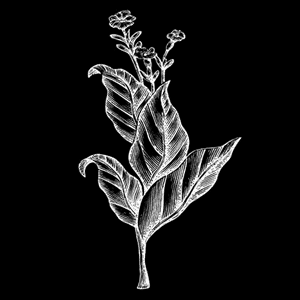
PAGES Tobacco Species
For the most part, there
are two species of tobacco plant that
are used by humans for the enjoyment of
nicotine. Nicotiana tobacum is the
one that is most prevelant, with
Nicotiana Rustica following at a distant
second. Nicotiana Tabacum leaves
contain nicotine content of about 1 to
3%, while Nicotiana Rustica leaves have
a nicotine content as high as 9%. Nicotiana
Tabacum Nicotiana Tabacum is a
robust annual little branched herb up to
2.5 m (8.2 ft) high with large green
leaves and long trumpet-shaped
white-pinkish flowers. All parts are
sticky, covered with short
viscid-glandular hairs, which exude a
yellow secretion containing nicotine. It
is found only in cultivation, and is
grown in many countries all over the
world for processing into tobacco.
Scientists believe that Nicotiana
Tabacum is a hybrid of the wild
Nicotiana species Nicotiana Syvestris,
Nicotiana Tomentosiformis, and possibly
Nicotiana Otophora. In their first voyage to
the New World, Christopher Columbus and
his expedition were introduced to
tobacco. Native
Americans throughout the New
World had likely used Nicotiana
Tabacum ritually,
socially, medicinally, and for
enjoyment for at least 2000 years
prior to Columbus'
journey. Tobacco use
spread into Europe, and from there
spread to the rest of the
world. Nicotiana
Tabacum originated in tropical
and subtropical America but it is now
cultivated commercially worldwide. Other
varieties of the Nicotiana genus are
cultivated as ornamental plants or grow
wild as a weed. Every part of the tobacco
plant except the seeds contains
nicotine, but the concentration is
related to different factors such as
species, type of land, culture and
weather conditions. The concentration of
nicotine increases with the age of the
plant. The regions that have
histories of use of the plant include: Brazil: Leaves are heated
and the juice is squeezed out, mixed
with ash from bark of Theobroma
subircanum or other Theobroma species to
make an intoxicating snuff. The leaf
juice is taken orally to induce vomiting
and narcosis. Colombia: Fresh
leaf is used as poultice over boils
and infected wounds; the leaves are
crushed with oil from palms and used
as hair treatment to prevent baldness. Cuba: Extract of the
leaf is taken orally to treat
dysmenorrhea. East Africa: Dried
leaves of Nicotiana tabacum and
Securinega virosa are mixed into a
paste and used externally to destroy
worms in sores. Ecuador: Leaf juice is
used for indisposition, chills and
snake bites and to treat pulmonary
ailments.
Home
Types of Snuff
Snuffing Techniques
Snuff Misconceptions
Snuff Boxes, etc.
Snuff Tobacco Links
History of Tobacco
Famous
Snuff-Takers
Tobacco
Species<<<
Effects of Nicotine
ARCHIVE
Photo
Albums
Videos about Snuff
Articles about
Snuff
Quotes on Snuffs
Books
on Snuff
Phillips
Griffiths' Site
Chef
Daniel Memories
EXTRAS
Why I Created
this Site
Modern Snuff Blog
Modern Snuff
Facebook

Nicotiana Tabacum is used in
the production of most cigarettes,
cigars, chewing tobacco, dipping
tobacco, snus, and
snuff. Nicotiana Rustica
is used in a few snuff brands to
increase the nicotine content, and is
sometimes mixed into commercial snuffs
by individual snuff-takers for the
same purpose.
Fiji: Fresh root is taken orally for asthma and indigestion; fresh root is applied ophthalmically as drops for bloodshot eyes and other problems; seed is taken orally for rheumatism and to treat hoarsness.
Guatemala: Leaves are applied externally by adults for myasis, headache and wounds; hot water extract of the dried leaf is applied externally for ring worms, fungal diseases of the skin, wounds, ulcers, bruises, sores, mouth lesions, stomatitis and mucosa; leaf is orally taken for kidney diseases.
Haiti: Decoction of dried leaf is taken orally for bronchitis and pneumonia.
Iran: Infusion of the dried leaf is applied externally as an insect repellent; ointments made from crushed leaves are used for baldness, dermatitis and infectious ulceration and as a pediculicide.
Mexico (south-eastern): Among the ancient Maya, Nicotiana was considered a sacred plant, closely associated with deities of earth and sky, and used for both visionary and therapeutic ends. The contemporary Tzeltal and Tzotzil Maya of Highland Chiapas (Mexico) are bearers of this ethnobotanical inheritance, preserving a rich and varied tradition of Nicotiana use and folklore. The entire tobacco plant is viewed as a primordial medicine and a powerful botanical ‘‘helper’’ or ‘‘protector.’’ Depending on the condition to be treated, whole Nicotiana leaves used are used alone or in combination with other herbs in the preparation of various medicinal plasters and teas. In its most common form, fresh or ‘‘green’’ leaves are ground with slaked lime to produce an intoxicating oral snuff that serves as both a protective and therapeutic agent.
United States: Extract of Nicotiana Tabacum is taken orally to treat tiredness, ward off diseases, and quiet fear.
Tanzania: Leaves of Nicotiana tabacum are placed in the vagina to stimulate labor.
Canada: Leaves are extracted and made into an eye serum to ward off visions of supernatural spirits.
Nutritional value
A protein of the White–Brown Complex subfamily can be extracted from the leaves. It is an odourless, tasteless white powder and can be added to cereal grains, vegetables, soft drinks and other foods. It can be whipped like egg whites, liquefied or gelled and can take on the flavour and texture of a variety of foods. It is 99.5% protein, contains no salt, fat or cholesterol. It has been considered as a low calorie substitute for mayonnaise and whipped cream.
Other uses
All parts of the plant contain nicotine, which can be extracted and used as an insecticide. The dried leaves can also be used; they remain effective for 6 months after drying. The juice of the leaves can be rubbed on the body as an insect repellent. The leaves can be dried and chewed as an intoxicant. The dried leaves are also used as snuff or are smoked. This is the main species that is used to make cigarettes, cigars, and other smokable tobacco preparations. A drying oil is obtained from the seed.
Curing and Aging
After tobacco is harvested, it is cured (dried), and then aged to improve its flavor. There are four common methods of curing tobacco: air curing, fire curing, flue curing, and sun curing. The curing method used depends on the type of tobacco and its intended use. Air-cured tobacco is sheltered from wind and sun in a well-ventilated barn, where it air dries for six to eight weeks. Air-cured tobacco is low in sugar, which gives the tobacco smoke a light, sweet flavor, and high in nicotine. Cigar and burley tobaccos are air cured. In fire curing, smoke from a low-burning fire on the barn floor permeates the leaves. This gives the leaves a distinctive smoky aroma and flavor. Fire curing takes three to ten weeks and produces a tobacco low in sugar and high in nicotine. Pipe tobacco, chewing tobacco, and snuff are fire cured. Flue-cured tobacco is kept in an enclosed barn heated by flues (pipes) of hot air, but the tobacco is not directly exposed to smoke. This method produces cigarette tobacco that is high in sugar and has medium to high levels of nicotine. It is the fastest method of curing, requiring about a week. Virginia tobacco that has been flue cured is also called bright tobacco, because flue curing turns its leaves gold, orange, or yellow. Sun-cured tobacco dries uncovered in the sun. This method is used in Greece, Turkey, and other Mediterranean countries to produce oriental tobacco. Sun-cured tobacco is low in sugar and nicotine and is used in cigarettes. Once the tobacco is cured, workers tie it into small bundles of about 20 leaves, called hands, or use a machine to make large blocks, called bales. The hands or bales are carefully aged for one to three years to improve flavor and reduce bitterness.
Nicotiana Rustica
Nicotiana rustica, Aztec tobacco, known in South America as mapacho and in Vietnam as thuoc lao, is a rainforest plant in the Solanaceae family. It is a very potent variety of tobacco. The high concentration of nicotine in its leaves makes it useful for producing pesticides.
Uses
Rustica is often used for entheogenic purposes by South American shamans. It contains up to nine times more nicotine than common species of Nicotiana such as Nicotiana Tabacum (common tobacco). Other reasons for its shamanic use are the comparatively high levels of beta-carbolines, including the harmala alkaloids harman and norharman. Most commonly, in South American ethnobotanical preparations, it is allowed to soak or be infused in water, and the water is then insufflated into the stomach in a preparation known as singado or singa; it is also smoked in cigars, used as an enema, made into a lickable product known as ambil, and made into a snuff with the bark of a species of Theobroma, creating nu-nu.
In the southeast part of Turkey, people use this herb and ashes of some tree bodies to make a moist snuff called maras otu. They use this by putting the mixture under their lips like Swedish snus or Afghan naswar. It is also a common admixture of Ayahuasca in some parts of the Amazon.
In Russia, N. rustica is called "makhorka". It was smoked casually by the lower classes before normal tobacco became widely available (after WWII), and is still sometimes smoked by peasants and farmers.
Thuoc lào
In Vietnam, it is most commonly smoked after a meal
on a full stomach to "aid in digestion", or along
with green tea or local beer (most commonly the
cheap "bia hoi"). A "hit" of thuoc lao is followed
by a flood of nicotine to the bloodstream inducing
strong dizziness that lasts several seconds. It
should be said however that even heavy cigarette
smokers have had trouble with the intense volume of
smoke, the high nicotine content, and that side
effects include nausea and vomiting.
The main difference between smoking thuoc lao and the use of other tobaccos is in the method of consumption, in that they are consumed with water pipe. The smoker is presented with either a bamboo pipe called a di?u cày (English: "farmer's pipe") or a ceramic hookah called a di?u bát. It may also occasionally be smoked in a more uncommon pipe known as a di?u ong. The pipe is filled with an appropriate amount of water and a small amount of thuoc lao is pressed into the bowl.
One then ignites the tobacco and inhales to create a body of smoke inside the pipe, before exhaling the smoke, reversing the process of air in the pipe by blowing into it to pop out the tobacco. The smoker then sharply inhales, usually tilting the pipe upwards to an almost horizontal position (but not completely, as the water would drain out the mouth).
Typically, on the streets of Vietnam's capital of Hanoi, a small bag containing enough tobacco for 5 to 8 "hits" retails at 2500 Vietnamese d?ng, which is equivalent to about 15 US cents. Larger packs cost up to 20000 d?ng and would be about $1.25 US Dollars. The use of thuoc lao is usually out of the bamboo pipe—the di?u cày—which can range from 10000 d?ng to upwards of 50000 d?ng for items with extravagant carvings and other designs.
Other Species of Tobacco
There are at least 67 species within the Nicotiana genus. We've described some of the more interesting ones below. But, unlike Nicotiana Tabacum and Nicotiana Rustica, these species are not widely used by humans.
Nicotiana Attenuata is a species of wild tobacco known by the common name "coyote tobacco." It is native to western North America from British Columbia to Texas and northern Mexico, where it grows in many types of habitat. It is a glandular and sparsely hairy annual herb exceeding a meter in maximum height.
Nicotiana Attenuata was used for a great variety of medicinal purposes by many Native American groups, and was smoked ceremonially by the Hopi, Apache, Navajo, Paiute, and other groups. Among the Zuni people, the smoke is blown over the body to reduce the throbbing from rattlesnake bite. It is also smoked ceremonially among them.
Nicotiana Clevelandii is a species of wild tobacco known by the common name "Cleveland's tobacco." It is native to northwestern Mexico and the southwestern United States in California and Arizona, where it grows in the Sonoran Desert, Colorado Desert, and in chaparral of the coastal canyons of the Peninsular Ranges and the Channel Islands of California.
Nicotiana Clevelandii is a glandular and sparsely hairy annual herb producing a slender stem up to about 60 centimetres (24 in) in maximum height.This plant was used for a variety of medicinal purposes and smoked in rituals by the Cahuilla.
Nicotiana Glauca is a species of wild tobacco known by the common name "tree tobacco." Its leaves and stems are neither pubescent nor sticky like Nicotiana Tabacum. It grows to heights of more than two meters.
Tree tobacco is native to South America but it is now widespread as an introduced species on other continents. It is a common roadside weed in the southwestern United States, and an invasive plant species in California native plant habitats.
The plant is used for a variety of medicinal purposes and smoked by Native American groups. The Cahuilla Indians used leaves interchangeably with other tobacco species in hunting rituals and as a poultice to treat swellings, bruises, cuts, wounds, boils, sores, inflamed throat, and swollen glands. Contains the toxic alkaloid anabasine. Ingestion of the leaves can be fatal. It is being investigated for use as a biofuel.
Nicotiana Persica is a species of tobacco which is cultivated in Iran. It is the source of Persian Tobacco made in ITC monopoly.
"Persian tobacco" is for example mentioned in the Mark Twain's book Innocents Abroad, Chapter XXXIV.
Nicotiana Quadrivalvis is a species of wild tobacco known by the common name Indian tobacco. It is native to the western United States, where it grows in many types of habitat. It is a bushy, sprawling annual herb growing up to two meters in maximum height.
Nicotiana Quadrivalvis was cultivated by indigenous peoples living on the west coast of North America, in particular southern Oregon and northern California, and along the middle Columbia River. Individually owned plots of tobacco plants were seeded with the previous year's seed capsules, tilled and weeded and fertilized in the fall by mixing in rotten wood after the harvest.
Further north, the Haida, Tlingit and probably Tsimshian cultivated a related but now extinct variety of tobacco in a similar manner. The original seeds must have been acquired from afar, as tobacco was not native to the northern Northwest Coast. Myths reflecting this, describe the supernatural original acquisition of the seeds.
Send comments to markstinson@onmail.com. Don't forget to visit our Blog and Facebook Group.
Modern Snuff © 2015, 2016, 2023 by Mark Stinson



